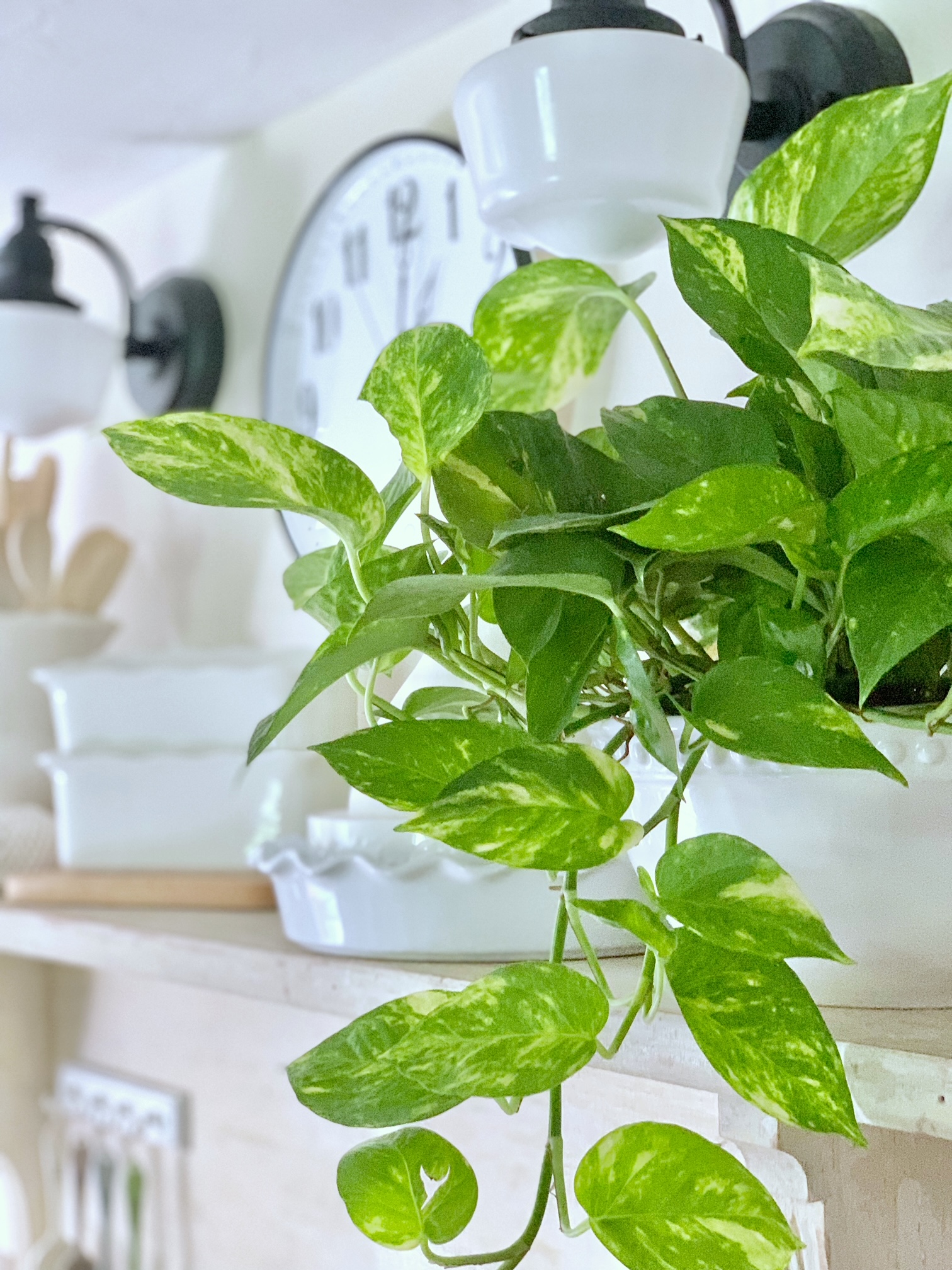Hey plant friends! Air plants are totally my thing. I just love their unique look and all the creative ways you can display these funky little Tillandsias without soil. If you’ve read my other air plant posts, you know they’re one of my favorite low-maintenance houseplants. But as popular as these beauties are, a lot of people struggle to keep them alive.
Proper care is key for long-lasting air plants. In this post, “How to Keep Air Plants Alive: Tips for Thriving Tillandsias” I’ll share my top tips so your air plants thrive for years. We’ll cover everything from sunlight to watering to troubleshooting common problems. Consider me your air plant sensei! I can’t wait to help you master the art of caring for these amazing Tillandsias. Let’s dive in and get your air game on point!

*This post includes affiliate links, for more info on affiliate links visit here
Getting to Know Tillandsias
To master the care of your air plant, we first need to understand what exactly makes these quirky plants tick. Tillandsias, commonly known as air plants and lovingly referred to as “Tillies”, are a genus of over 650 different species.1 Their natural habitats are in the mountains and forests of Central and South America. Tillies are epiphytes – meaning they grow on other objects without needing soil. Epiphytes species include Spanish moss (picture Spanish moss hanging from tree branches) and plants in the bromeliad family.
Some air plants have slender, cascading leaves while others form a rosette pattern. The one thing they all have in common? Tiny scales, called trichomes, give a fuzzy appearance to their leaves and are responsible for absorbing water and nutrients.2
Now air plants can be grouped into two main types based on their native environment:
Xeric air plants hail from arid areas like deserts.3 They have thick, silvery trichomes to capture moisture. Xeric Tillies can tolerate more sun and require less frequent watering.
Meanwhile, Mesic air plants come from tropical rainforests.4 They have finer trichomes and bright green foliage adapted to high humidity. Mesic types need more shade and frequent watering.
Understanding these differences is key to keeping your Tillies alive! Now let’s get into the nitty gritty of care.
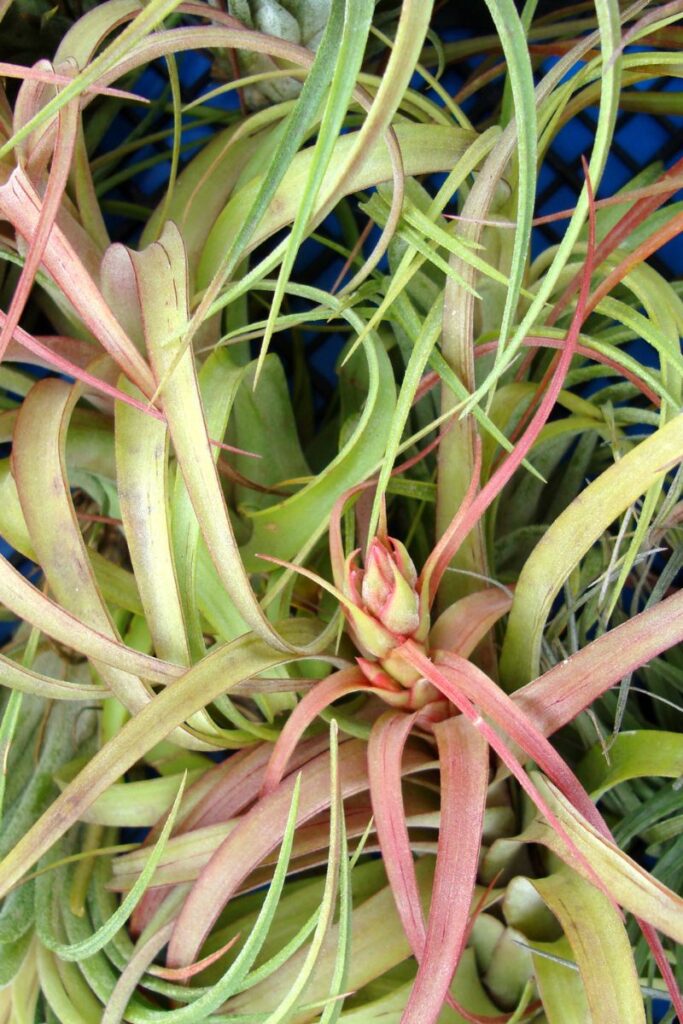
Creating the Perfect Indoor Environment for Air Plants
Air plants thrive when you replicate the warm, humid conditions of their natural habitat. Here are some tips for getting your indoor environment just right:
Temperature
- Tillandsias grow best with temperatures between 60-80°F
- Avoid placing near hot and cold air vents
- Monitor temps to ensure they don’t dip too low in winter
Humidity
- Ideal humidity level is 50-70%
- Increase humidity by: Grouping plants together, using a humidifier or placing plants on pebble trays.
Lighting
- Indoor air plants need 4-6 hours of bright, indirect sunlight daily
- Avoid direct southern sun exposure
- Supplement with full spectrum grow lights
Air Circulation
- Improves air quality
- Helps leaves dry efficiently after watering
- Use small fans to create a gentle breeze
Mimicking the warm, humid, bright environments of their native climates keeps air plants happily thriving. Monitor conditions closely and adjust as needed throughout the seasons.
For more information on getting the right amount of sunlight for your ir plants visit my Do Air Plants Need Sun? (Choosing the Ideal Spot) post.
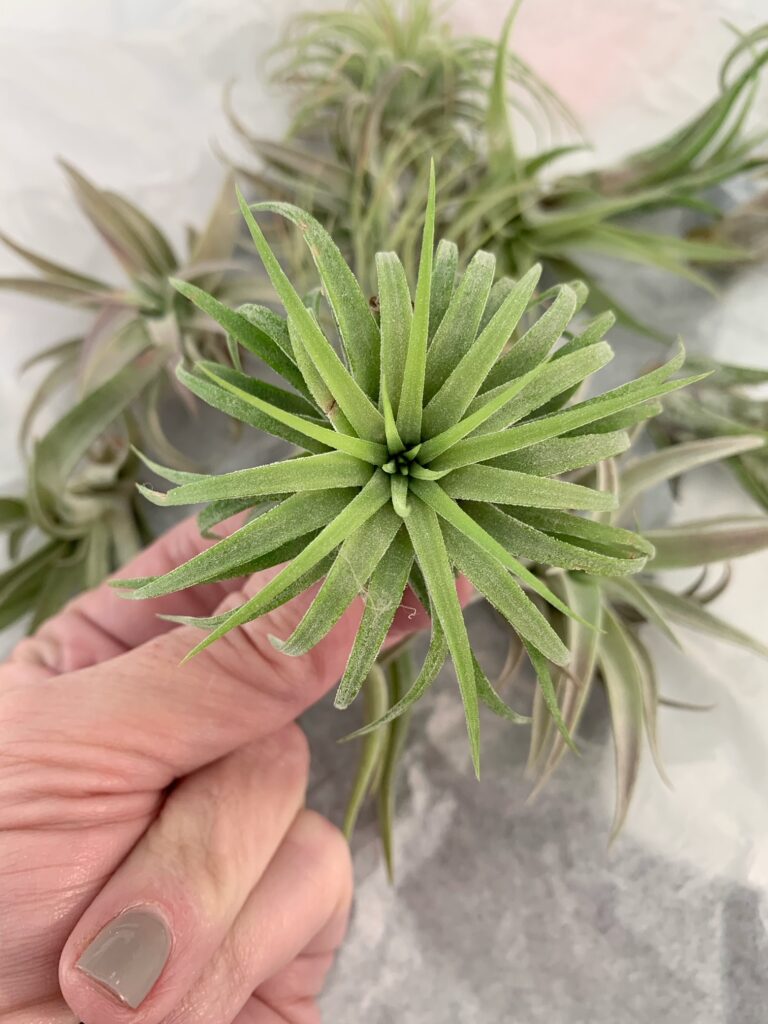
Mastering the Art of Watering Air Plants
Unlike most houseplants, air plants don’t have extensive root systems to absorb water. They rely on their leaves and trichomes to take in moisture. That means we have to tailor watering methods and frequency to suit these unique Tillandsias.
The three main watering techniques are:
Soaking – Fully submerge the entire plant for a good soak in room temperature filtered water for 1-3 hours weekly. Gently shake off excess moisture before returning plants to display.
Dunking – Fill a bowl with room temperature water and dunk air plants up and down for 30 seconds several times a week. Remove promptly and shake off excess water.
Misting – Use a spray bottle to mist plant leaves every 2-3 days. Dry leaves thoroughly to avoid rot.
How often you soak, dunk, vs mist depends on your climate and indoor conditions. In dry environments, increase soaking time and mist more frequently between soakings. Reduce frequency in humid climates.
Always use distilled or filtered water to avoid damage from minerals and chemicals. Tap water can be left out 24 hours for chlorine to evaporate.
Underwatered plants appear shriveled or brown. Overwatered air plants feel mushy or rotting. Adjust your schedule based on how plants respond.
For more information of best practices for watering your air plants visit my How Often to Mist Air Plants: A Complete Guide post.
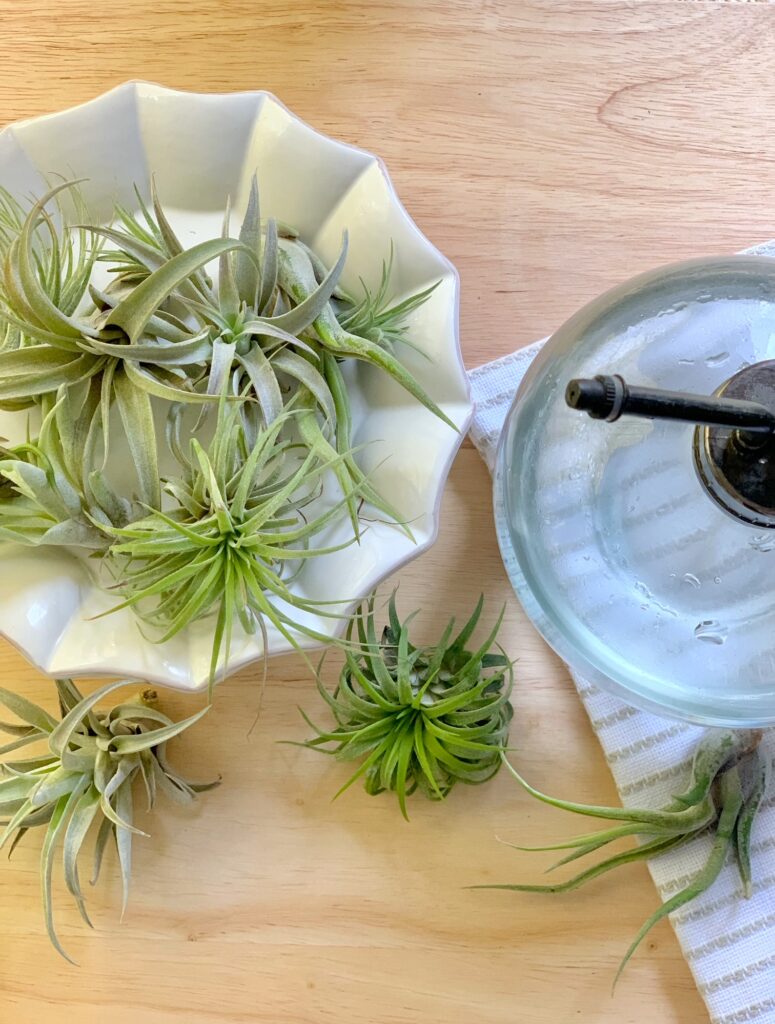
Giving Your Air Plants a Nutrient Boost
Air plants get most of their nutrients from water and air. However, providing supplemental fertilizer can encourage lush growth and vivid colors.
The main nutrients air plants need are:
- Nitrogen for healthy foliage
- Phosphorus to promote blooming
- Potassium for disease resistance
Look for a fertilizer formulated specifically for air plants and Tillandsias. Choose a balanced blend, not one that’s nitrogen-heavy.
Apply at 1/4 to 1/2 the recommended strength to avoid burn. Fertilize sparingly every 2-3 months during the growing season. More isn’t better!
Soak plants in fertilizer solution for 30-60 minutes or use a mister to apply it to leaves. Thoroughly rinse plants after to prevent chemical buildup.
While fertilizer can give your air plants a boost, it’s no substitute for proper water, light, and care. Focus on dialing in the basics before turning to supplements!
Shop Air Plant Fertilizers:
DIY Homemade Air Plant Fertilizer:
Ingredients:
- 1 gallon of water
- 1 tablespoon of Epsom salt (magnesium sulfate)
- 1 teaspoon of baking soda (sodium bicarbonate)
- 1 teaspoon of household ammonia (optional, for nitrogen)
Instructions:
- Fill a gallon-sized container with water. It’s best to use distilled or filtered water to avoid any mineral buildup on your air plants.
- Add 1 tablespoon of Epsom salt to the water. Epsom salt provides magnesium, which is essential for plant growth and chlorophyll production.
- Mix in 1 teaspoon of baking soda. Baking soda helps to adjust the pH of the water, making it more suitable for air plants.
- If desired, you can add 1 teaspoon of household ammonia to the mixture to provide nitrogen, which supports healthy foliage growth.
- Stir the ingredients well until everything is dissolved.
- Transfer the fertilizer solution to a spray bottle or a watering can for easy application.
How to Use:
- Use this homemade fertilizer solution to mist your air plants or soak them in it for about 20-30 minutes once a month during the growing season (spring and summer).
- Make sure not to over-fertilize your air plants, as they are sensitive to fertilizer buildup. Using this homemade fertilizer sparingly will provide the necessary nutrients without overwhelming your plants.
This homemade fertilizer provides essential nutrients for your air plants’ growth and health. Adjust the frequency of application based on your plants’ response and the environmental conditions they are exposed to.
Learn more about fertilizing plants in my Indoor Plant Fertilizers You Can Make at Home (Feed Your Plants the Natural Way) post.

Getting Creative with Air Plant Displays
One of the best parts of owning air plants is finding unique ways to show off their beauty. Here are some fun display ideas to highlight your Tillandsias:
- Glass terrariums – Air plant terrariums are great for creating a mini oasis, just be sure to keep the lid propped open for ventilation
- Hanging glass globes – Allow sunlight to filter through and cast a glow on plants
- Mounted on driftwood – Mimics natural epiphytic environment on bark
- Nested in seashells – For beachy vibes
- Perched on stones – Stack river rocks or geodes for an earthy look
- Macrame hangers – Let plants cascade at different heights
You can also get creative with household items like conch shells, vases, or wire baskets!
The options are endless – just be sure your display allows for proper light and air circulation. Show off your Tillandsias’ unique shapes and let them shine!

Shop Air Plant Displays
Encouraging Flowers and Creating New Plants
One of the most exciting parts of growing air plants is when your Tillandsia bursts into bloom! Here’s how to encourage flowering:
- Maturity – Most air plants need to be 3-5 years old before blooming
- Seasonal sunlight – Extra sun in spring and summer can initiate buds
- Avoiding pest damage – Thrips and fungi prevent flowering
- Proper nutrients – Boost phosphorus to promote blooming
An air plant bloom will last 3-6 months. Keep watering during this time but avoid soaking the flower. When it fades, cut the stalk near the base.
Many air plants also produce pups or offshoots you can use for propagation. When pups reach 1/3 the size of the mother, carefully detach at the base using sterile shears. Plant the pup in new air plant soil and grow into mature plants!
With the right care and conditions, your air plants will reward you with flowers and babies to expand your collection.
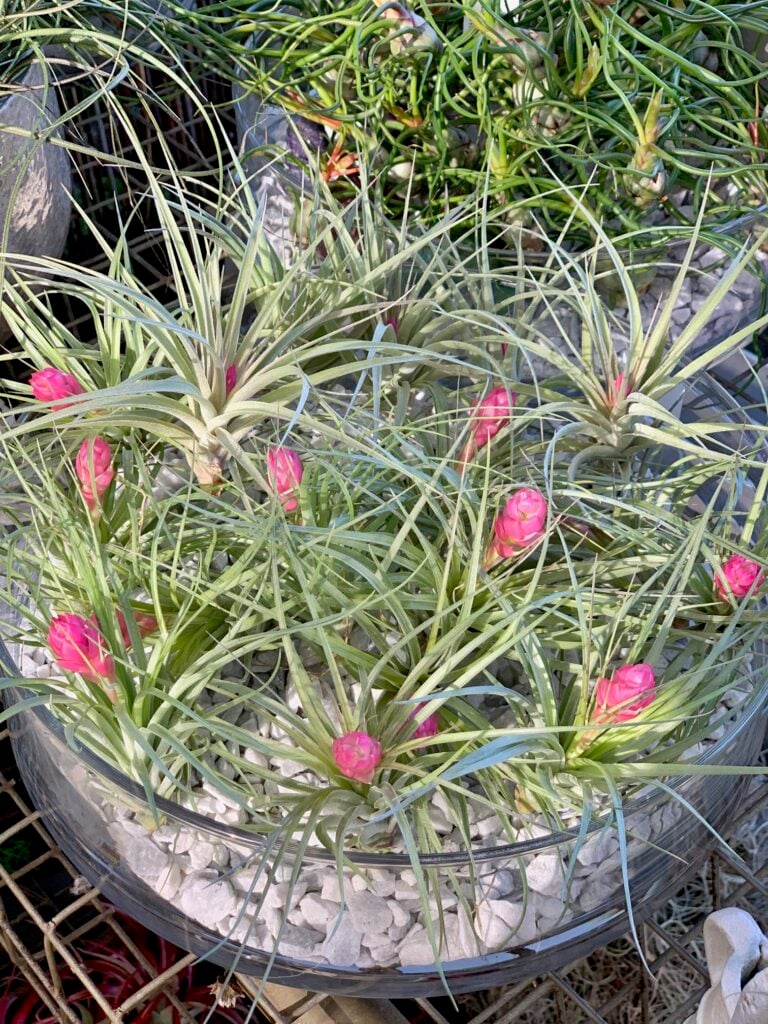
Multiplying Your Air Plant Collection
Once your air plants mature, you can propagate new baby Tillandsias through offsets or seeding.
Pups or Offsets – The easiest way is to separate developed pups from the parent plant and repot. Use sterile shears to detach pups at the base when they reach 1/3 mother’s size. Plant in air plant soil.
Seeds – Viable for advanced growers. Tillandsia seeds need sterile conditions, specific mediums like agar, and extended germination periods. Thorough research is a must.
Pups allow beginners to easily propagate new identical air plants. But seeds let you grow fresh hybrids and rare species.
If sowing seeds, use small shallow containers like petri dishes filled with proper sterile medium. Cover to retain humidity during germination.
For more information on propagating air plants visit Wikihow’s article, How to Propagate Air Plants. With propagation know-how, your air plant collection can multiply quickly! Start with pups to hone your skills.
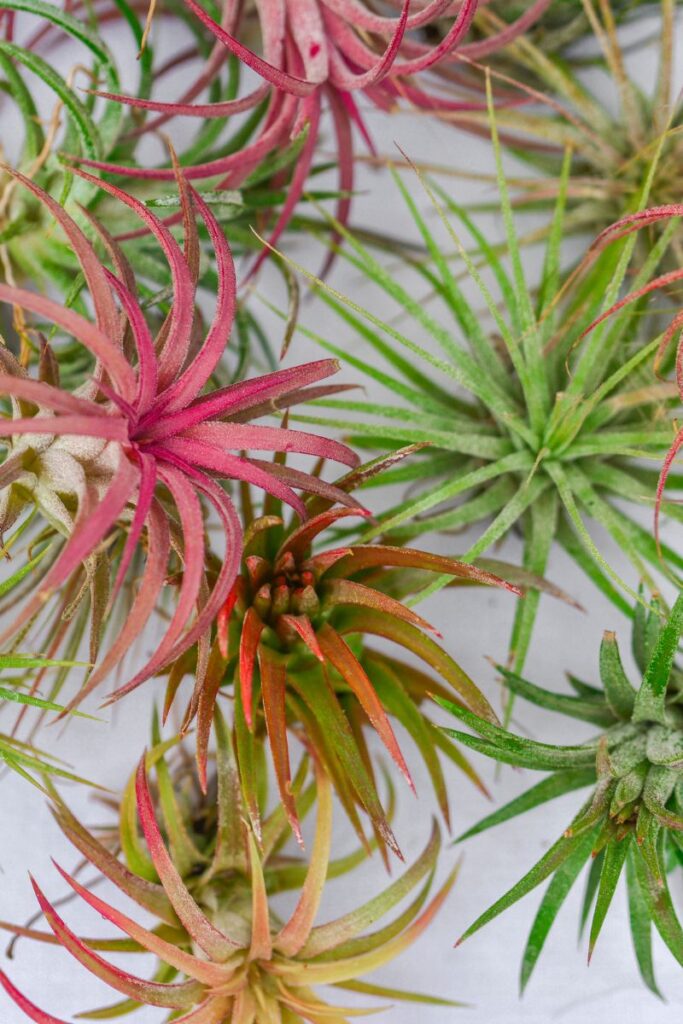
Choosing Air Plants: Your Green Journey Starts Here
You’re ready to bring some air plant enchantment into your life, but where do you begin? Let’s explore the world of air plant varieties (air plant species) and find the perfect fit for you, whether you’re a budding green thumb or an experienced plant whisperer.
For Beginners: Easy Does It
If you’re new to the wonderful world of air plants, it’s wise to start with varieties that are forgiving and a joy to care for. Here are a few that’ll make your green journey a breeze:
- Tillandsia Ionantha: This little gem is a beginner’s dream. It’s resilient and can thrive in a range of conditions. Whether you’re a forgetful waterer or an overzealous one, the Ionantha is your friend.5
- Tillandsia Xerographica: For those who like a statement piece, the Xerographica is a larger air plant that’s also beginner-friendly. With its unique appearance and easy-going nature, it’s hard not to fall in love.6
- Tillandsia Brachycaulos: This medium-sized beauty boasts vibrant red tones and is incredibly adaptable. It’s a great choice for beginners looking to add a pop of color to their space.7
Tip: Visit Gardening Know How‘s article, Types Of Tillandsia to see the many beautiful options!
For Experienced Plant Owners: Dare to Explore
If you’ve got a few plants under your belt and are ready to take your air plant game to the next level, these more delicate air plant varieties are perfect for you:
- Tillandsia Caput-Medusae: With its intriguing appearance, the Caput-Medusae requires a bit more care. It’s worth the extra effort, though, as it can be a stunning addition to your collection.8
- Tillandsia Bulbosa: The Bulbosa has a unique, wild appearance that experienced plant owners will appreciate. It’s more delicate and demands a bit more attention, making it a rewarding choice for those with a green thumb.9
- Tillandsia Streptophylla: With its beautifully curly leaves, the Streptophylla is a sight to behold. It’s a bit more delicate than some, so it’s perfect for plant enthusiasts who love a challenge. [6]

But Wait, There’s More: Tips for Selection
When you’re ready to choose your air plants, here are some tips to keep in mind:
- Size Matters: Consider the size and space available in your home. Some air plants are more compact, while others can grow larger.
- Mix and Match: Don’t limit yourself to just one variety. Create a diverse collection of air plants to keep things interesting.
- Product Recommendations: Look for reputable sources and suppliers for your air plants. Online marketplaces and local nurseries are excellent options.
- Research is Key: Every air plant variety has unique care requirements. Do your research and understand the specific needs of each plant to ensure they thrive.
Troubleshooting Common Air Plant Issues
Even with the best care, air plants can sometimes run into problems. Here are some common issues and fixes:
| Common Issue | Causes | Signs | Fixes |
|---|---|---|---|
| Rotting | Improper watering or poor drainage | Base turns black, mushy leaves | Improve air circulation, reduce watering in humid conditions |
| Dehydration | Underwatering or low humidity | Dried, brown, curled leaves | Increase misting and soaking, move to higher humidity area |
| Sunburn | Direct sun exposure | Leaves turn yellow or brown | Keep in bright, indirect light, acclimate to increased sun |
| No New Growth | Insufficient light, nutrients, moisture | Stunted or no new growth | Review care regimen, adjust as needed |
| Pest Damage | Scale, mealybugs, thrips | Visible pests, leaf damage | Isolate and treat with insecticidal soap, ensure proper drying after watering |
Catching issues early allows for quick recovery. Always assess conditions and care when problems arise – an air plant is a window to its environment!

Seasonal Care and Considerations
As the seasons change, your air plants need some adjustments to stay happy and healthy. Temperature, daylight, and humidity levels all influence how your Tillies are feeling.
Adjusting to the Seasons: Here’s the scoop – when the weather cools down or heats up, your air plants might need a tweak in their care routine. In colder weather, indoor air tends to dry out, so your plants might benefit from more frequent misting to stay hydrated. Conversely, during summer, they might appreciate a bit more shade to avoid sunburn.
Tackling Seasonal Challenges: Winter can bring dry indoor air, which isn’t ideal for air plants. Combat this by increasing humidity with water trays or more frequent misting. And when summer heatwaves hit, provide shade or bring them indoors to avoid excessive sun exposure.
Keeping Them Cozy: Extreme temperatures and drafts aren’t air plants’ cup of tea. Keep them away from vents or drafty windows in winter, and during freezing weather, consider moving them to warmer spots in the room.
There you have it – some simple tips to help your air plants sail through the seasons. Remember, a little adjustment can go a long way in ensuring your Tillandsias thrive, rain or shine!
Frequently Asked Questions about Caring for Air Plants
Air plants are water-thrifty wonders! Typically, soak them in room temperature water for 1-3 hours every 1-2 weeks. Or, give them a quick dunk several times a week. Mist them between soakings in dry environments. For more information visit my post on the water requirements of air plants.
During colder months, reduce watering frequency to once a month or when the plants appear thirsty. Maintain the same indoor environment and ensure they don’t experience temperature drops below 50°F.
You can propagate air plants through “pups” or offsets, which are mini Tillandsias that grow alongside the mother plant. Gently separate them when they reach 1/3 the mother’s size and repot. For advanced growers, air plant seeds are another option, but they require specific conditions and patience.
Air plants thrive in bright, indirect sunlight. Set them near a window with filtered light, but avoid too much light. If you lack natural light, consider supplementing with artificial light using full-spectrum grow lights. For more information, visit my post on sunlight requirments for air plants.
With proper care, these house plants can live for several years, sometimes even decades! The good news is a healthy air plant will flower and produce “pups” during their lifetime, adding to your collection.
The growth rate of air plants, also known as Tillandsias, varies depending on the species and environmental conditions. On average, air plants tend to grow slowly, with an annual growth rate of around 1-3 inches. Some species may grow faster, while others may be more gradual in their growth, making them a patient gardener’s delight.
The sky’s the limit! You can showcase them in glass terrariums, hanging glass globes with a fishing line, mounted on driftwood, nestled in seashells, or perched on stones. Don’t forget about macrame hangers or quirky household items. Just ensure they receive proper light and air circulation for thriving displays. Visit my Where to find air plants post which provides instructions on how to make an air plant candle ring.

Air plant candle ring instructions
Air plants have truly stolen my heart with their unique charm and endless creative possibilities. But, let’s face it, even though they’re popular, many people find it challenging to keep their air plants alive. The secret to a flourishing air plant collection? Well, my friends, it all boils down to proper care of air plants. In this post, “How to Keep Air Plants Alive: Tips for Thriving Tillandsias,” I’ve spilled the beans on my simple tips to ensure your air plants thrive for years to come. So, embrace the unique world of air plants, and you’ll be rewarded with green beauty, delicate blooms, and the satisfaction of nurturing these remarkable Tillandsias. Here’s to your flourishing air plant journey – may your Tillies thrive, your collection grow, and your green thumb continue to bloom!
Keep growing friends!

References
- Air Plants—A Trendy Plant with a Long Story! (Rutgers NJAES). (n.d.). https://njaes.rutgers.edu/plant-of-the-month/tillandsia.php ↩︎
- Tillandsia ionantha (Air Plant) | North Carolina Extension Gardener Plant Toolbox. (n.d.). https://plants.ces.ncsu.edu/plants/tillandsia-ionantha/ ↩︎
- Tillandsia (Air Plants). (n.d.). https://extension.psu.edu/tillandsia-air-plants#:~:text=Xeric%20air%20plants%20are%20from,to%20absorb%20water%20and%20light. ↩︎
- https://warren.cce.cornell.edu/gardening-landscape/warren-county-master-gardener-articles/air-plants-tillandsia ↩︎
- Wikipedia contributors. (2023, November 20). Tillandsia ionantha. Wikipedia. https://en.wikipedia.org/wiki/Tillandsia_ionantha ↩︎
- Wikipedia contributors. (2023b, November 21). Tillandsia xerographica. Wikipedia. https://en.wikipedia.org/wiki/Tillandsia_xerographica ↩︎
- Wikipedia contributors. (2023a, June 23). Tillandsia brachycaulos. Wikipedia. https://en.wikipedia.org/wiki/Tillandsia_brachycaulos ↩︎
- Wikipedia contributors. (2021, April 29). Tillandsia caput-medusae. Wikipedia. https://en.wikipedia.org/wiki/Tillandsia_caput-medusae ↩︎
- Wikipedia contributors. (2023a, June 15). Tillandsia bulbosa. Wikipedia. https://en.wikipedia.org/wiki/Tillandsia_bulbosa ↩︎






